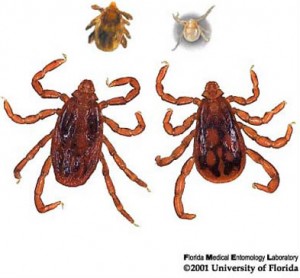READY TO GET STARTED?
REQUEST A FREE ESTIMATE
Fill out the form below or call (888) 466-7849 for a free, no-obligation estimate.
The spring season is a time when all members of the family, including pets, wander outdoors to enjoy the sunshine and blossoming flowers. Unfortunately, it’s also prime pest season, which means pets are at risk of encountering hungry fleas and ticks that are in search of active hosts. Northwest Exterminating encourages pet owners to take precautions against these dangerous pests during the warmer months.
Fleas are more than just an itchy annoyance. Their saliva can cause anemia, dermatitis and can transfer tapeworms in dogs and cats. Ticks can spread bacteria to pets and cause tick paralysis, which occurs when a female tick attaches near a pet’s spinal cord. This condition can lead to muscle weakness, loss of coordination and in some cases, death from respiratory failure as chest muscles become paralyzed.
In addition to the health threats posed by fleas and ticks, both pests are small in size and extremely mobile, making them difficult to detect and get rid of once inside the home. It’s extremely important for pet owners to be cautious of these pests and contact a licensed pest professional if they suspect an infestation.
The National Pest Management Association, a nonprofit organization committed to the protection of public health, food and property from household pests, offers these tips to keep pets pest-free:
Source: NPMA
It’s important to protect yourself and your pets from ticks this season! Keep reading for more information on the little suckers!
BRIEF DESCRIPTION
HABITS
SPECIES
THREATS
PREVENTION
OTHER PESTS TO LOOK OUT FOR
Call Northwest Exterminating for information on how to protect your home and loved ones from ticks.
Each warm season brings questions from homeowners and pet owners regarding ticks. We worry about our furry family members and ourselves if we plan on spending time outdoors, especially in or around wooded areas.
The brown dog tick is one species of tick that should be cause for concern, especially for those who have dogs. Although they feed on a wide variety of mammals, dogs are their preferred host. These ticks are unique in that they can complete an entire life cycle indoors. They feed on the host for about a week before dropping off and laying their eggs…up to 5,000 eggs!! After she’s done laying her eggs, she dies. The full life cycle of a brown dog tick lasts just over two months and generally are long living creatures.

Tick Life Cycle – Source
A brown dog tick infestation can develop in high quantities and very quickly. Oftentimes, ticks go unnoticed on dogs until the ticks are spotted throughout the home.
To protect your home and your dog from brown tick infestation, here are some brown dog tick control tips:
For more detailed information on the brown dog tick, visit http://www.entnemdept.ufl.edu/creatures/urban/medical/brown_dog_tick.htm.
 They don’t call him Man’s Best Friend for no reason. Dogs, and cats (we can’t forget our beloved cats) are truly part of the family. We treat them and take care of them just as we would any other member of the family. That’s why it is important that we protect them from outdoor pests that can cause serious health risks to our furry friends. Ticks, fleas, and mosquitoes are all predicted to make a heavy appearance this season as the weather warms up.
They don’t call him Man’s Best Friend for no reason. Dogs, and cats (we can’t forget our beloved cats) are truly part of the family. We treat them and take care of them just as we would any other member of the family. That’s why it is important that we protect them from outdoor pests that can cause serious health risks to our furry friends. Ticks, fleas, and mosquitoes are all predicted to make a heavy appearance this season as the weather warms up.
Ticks are most commonly found on our pets. Ticks can carry Lyme disease, Rocky Mountain Spotted Fever, and cause tick paralysis.
Fleas can cause itchy, red bumps that cause animals to scratch. Fleas are also easily brought into the home where they can invade your living space and reproduce. Fleas can cause anemia, skin issues, and even tapeworms for our pets.
Heartworms and West Nile Virus are some of the more serious issues that come along with mosquitoes. A bite can manifest into a full heartworm in 6-7 months in a dog, and 8 months in a cat.
Keep your pets healthy by following some of these tips to controlling ticks, fleas, and mosquitoes:
Contact Northwest Exterminating if you think you have a problem with fleas, ticks, or mosquitoes. Keep your pets healthy!
How can something as small as a flea be such a huge pain? Pet owners are all too familiar with the annoyance of fleas because they make us AND our pets miserable. Fleas attach themselves to warm-blooded animals (pets and humans) and feed on their blood. A flea bite can cause discomfort, painful, itchy red bumps and can lead to an allergic reaction. In some cases, they can even transmit diseases like the bubonic plague, murine typhus and transfer tapeworms in pets.
To prevent fleas from becoming a pest in your home, clean and vacuum frequently. A clean home is a healthy home and will aid in the prevention of other pests as well. Cleaning will help to remove any fleas and their eggs. Maintaining a clean yard is just as important, especially if you have pets that go outside often. A well kept lawn with no debris or pet droppings will reduce the flea population around your home. Bathe pets regularly and apply a flea and tick treatment. Most importantly, call a professional exterminator if you have fleas in your home. A flea infestation can be very difficult to get rid of and is best left to the professionals so the problem does not continue to grow.
Interesting Flea Facts:
Got a flea problem? Call Northwest Exterminating for professional, effective flea control.